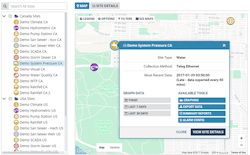Los Angeles County Sanitation Districts Selects FlowWorks Software
The Los Angeles County Sanitation Districts has selected FlowWorks software for real-time reporting and analytics on a wastewater system that services 5.6 million people. The California agency has awarded a two-year contract after which it is renewable on an annual basis.
Covering approximately 850 square miles and encompassing 78 cities and unincorporated areas in Los Angeles County, the agency operates and maintains a regional wastewater collection system which includes approximately 1,400 miles of sewers, 48 pumping plants and 11 wastewater treatment plants. Collectively, the Sanitation Districts treat about 400 million gallons of water per day, which is enough to fill the famous California Rose Bowl stadium nearly five times a day. Over the last 50 years, the Los Angeles Sanitation Districts have been the USA’s largest producer of recycled water – a worthy accomplishment given the impacts of climate change on southern California’s watersheds.
“The reason we chose this software is because we were upgrading our existing flow meters that had become obsolete, and while doing our research, we discovered that with new meters, we had an opportunity for a new way to present our flow data,” said Civil Engineer Julio Fernandez.
“We had several forms of flow and level data coming from our own meters and from several flow contractors that needed to be brought all together and presented in a single interface,” stated Darrell Hatch, Supervising Engineer.
The agency is implementing the FlowWorks software over the course of 2022. “Eventually we see another opportunity to look at data from our storm water diversion programs,” said Hatch. “If the data shows we have available capacity in our collection system, we could divert dry weather flows and small amounts of early first-flush rainfall flows into the treatment facilities. This will increase our reclaimed water amounts and help protect water quality for the receiving waters downstream from the locations of those diversion sites.”
Fernandez and Hatch also look forward to exploring new Artificial Intelligence (AI) and Machine Leaning (ML) capabilities once data migration and standardization is complete from five main data sources that include more than 20,000 . “It’s a big jump in how we can analyze our data,” said Fernandez. “Eventually we will have several hundred continuous-level flow meters throughout our system to feed into data modeling and machine learning applications,” added Hatch. “We have a big push for this advanced technology.”
